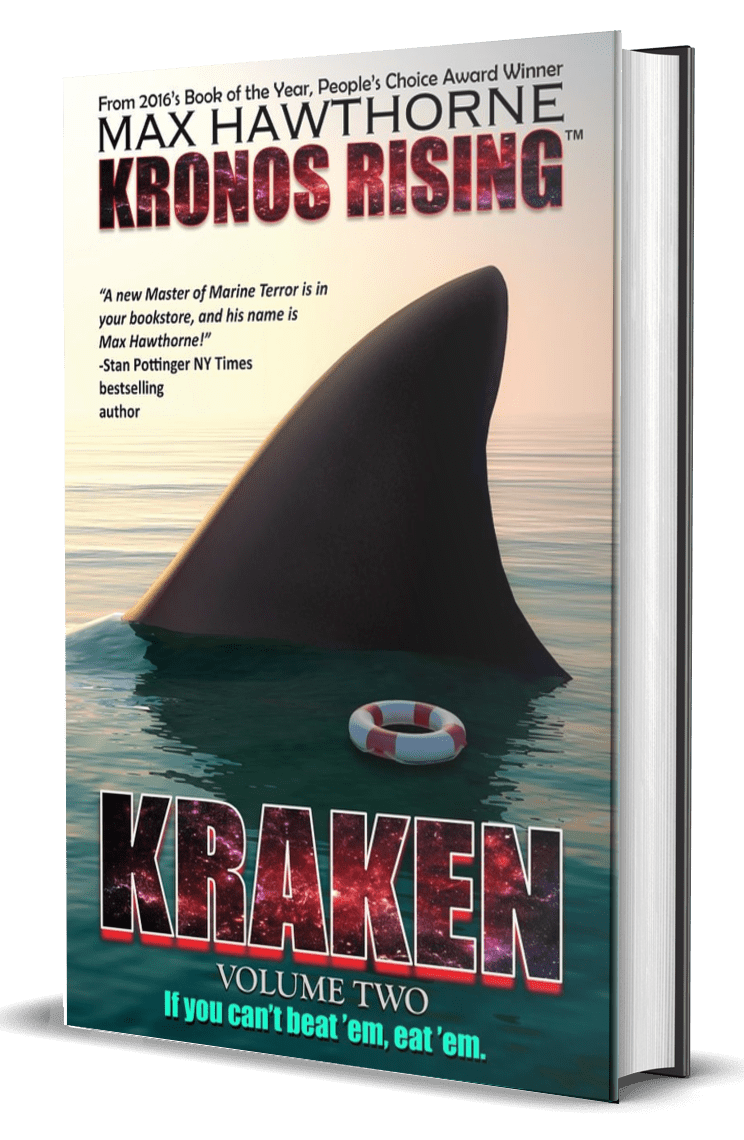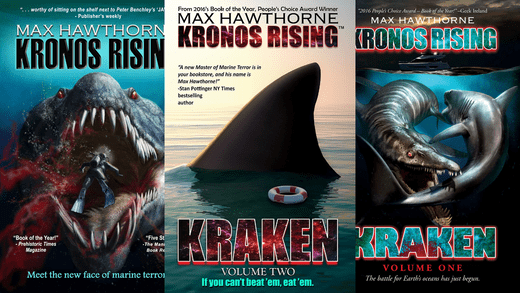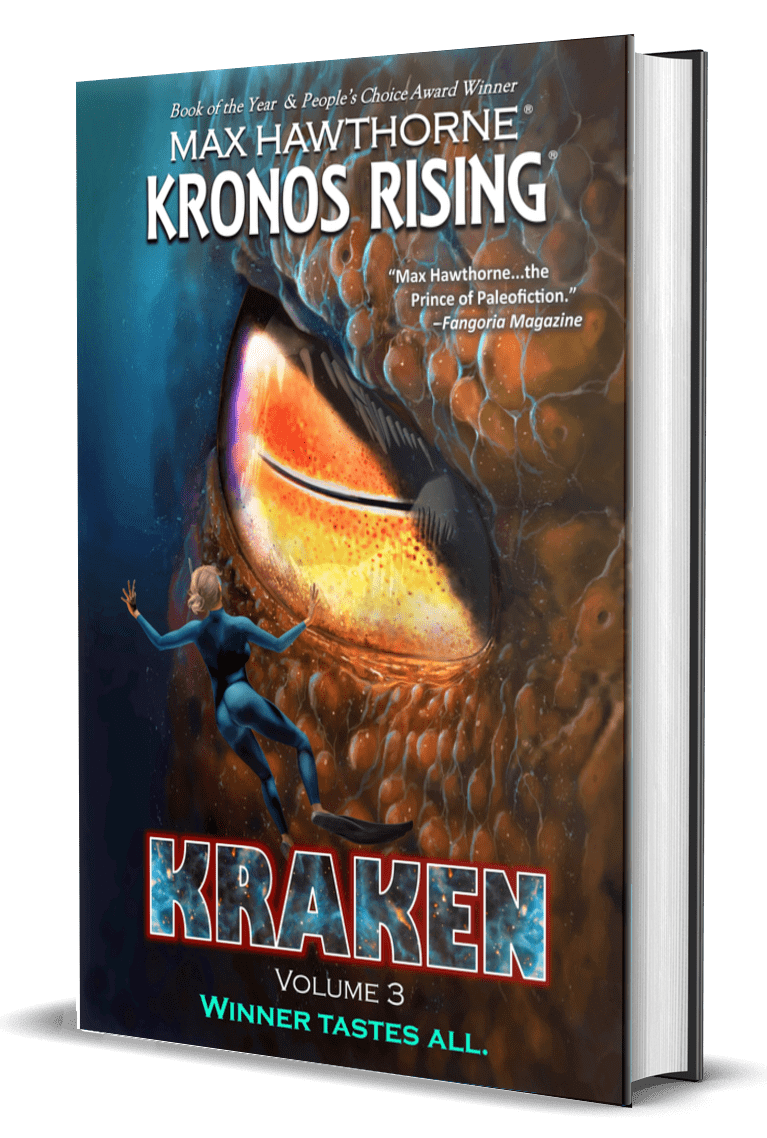Otodus obliquus was a large, macropredatory mackerel shark that lived from the Paleocene to the Miocene Epoch, approximately 40-60 mya. Although nowhere near as well-known as its descendant, the 40-ton, 50-foot whale-eater, Carcharocles (now Otodus) megalodon, O. obliquus (or simply Otodus for purposes of this article) was a formidable predator in its own right. In fact, many consider it the apex predator of its day.
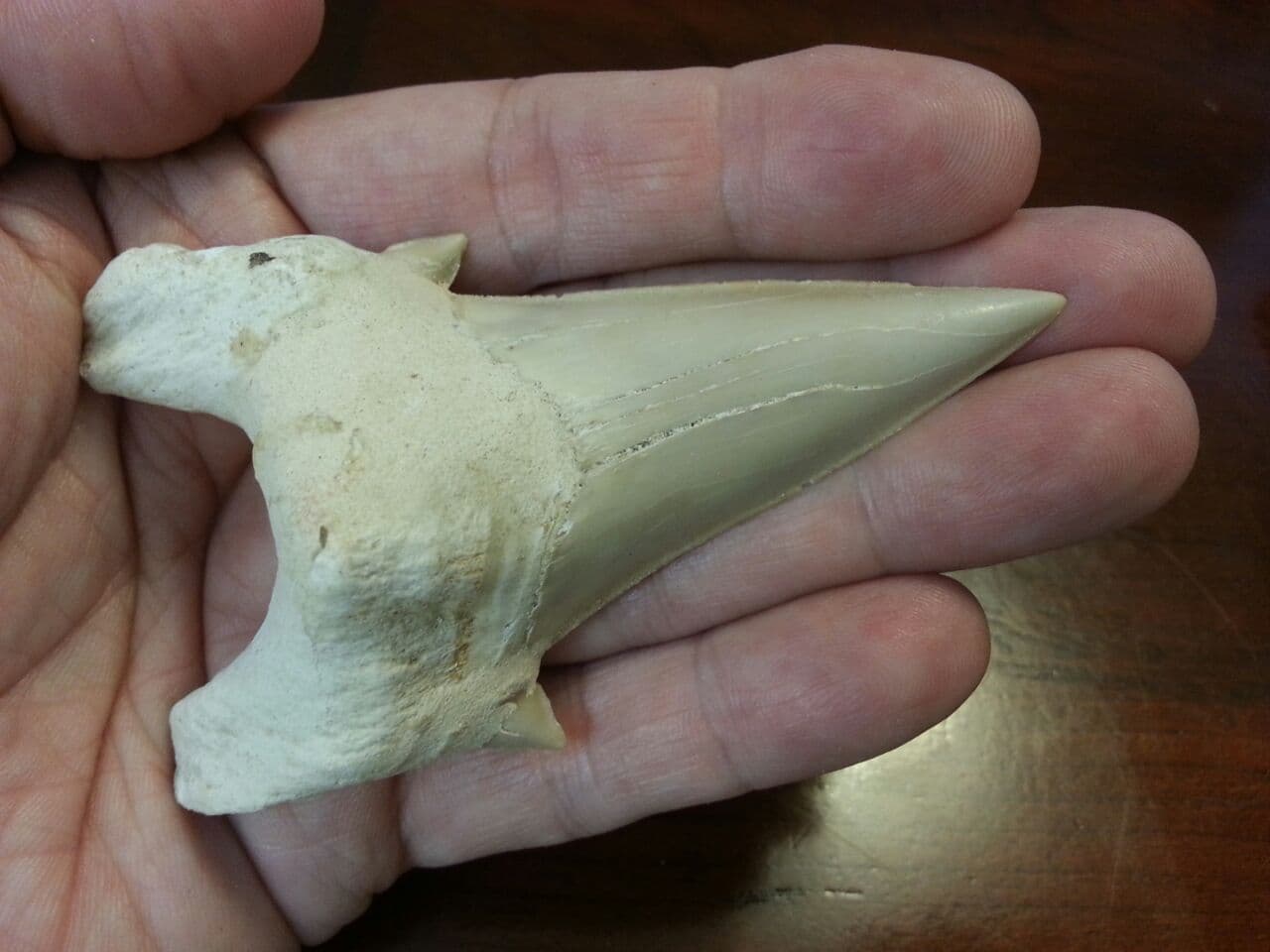
A descendant of the Cretaceous shark genus Cretolamna, which survived the asteroid impact 65+ million years ago that spelled doom for non-avian dinosaurs and a large percentage of marine life, Otodus evolved to fill the ecological niche that had appeared in Earth’s suddenly mosasaur-free seas.
Whereas Cretolamna (66-56 mya) generally reached lengths of only 7-10 feet, Otodus was a veritable monster for its time, reaching 30+ feet in length and weighing in excess of 8 tons (note: any notions on Wikipedia that the shark reached 40’ are an exaggeration; enamel-height formulas indicate a more realistic 30 feet)

Although we have no way of knowing for certain what Otodus looked like, based on its tooth morphology, I picture it as a gigantic, beefed-up Mako shark, albeit with a blunter snout. Its mass might have denied it the Shortfin Mako’s phenomenal acceleration, but once it got moving it was a veritable powerhouse, capable of devastating charges, with speeds approaching 25 mph. This image gives an idea of what it would be like for a modern diver to encounter the Orca-sized shark face to face. Not a pleasant proposition.

In terms of prey, the Eocene seas that Otodus roamed were warm and teeming with life, and it evolved to feed on all of it. This included large bony fish, turtles, ancestral whales, sirenians, and even other sharks. This would have included the ancestors of today’s requiem sharks – our tiger, blue, and bulls. The only predator that rivaled Otodus, and may even have preyed upon it, was the prehistoric whale Basilosaurus (approx. 40-35 mya) Reaching lengths of well over sixty feet and, despite its long, serpentine build, twice or even thrice the weight of Otodus, Basilosaurus was a voracious predator with lethal jaws capable of an impressive bite. Also known as Zeuglodon, it feasted on the same prey items Otodus did, including other sharks. With the prehistoric whale appearing on the scene at approximately the same time the huge mackerel shark vanished, one can’t help but wonder if clashes between these two super predators contributed to one another’s decline.

Like any shark, the business end of Otodus obliquus was its yard-wide jaws. Sporting dagger-like teeth up to 4 inches in length, with sharp edges and visible cusps on the roots, Otodus had a lethal bite. In fact, its jaws were a veritable meat processing station – designed to shred anything they came in contact with.
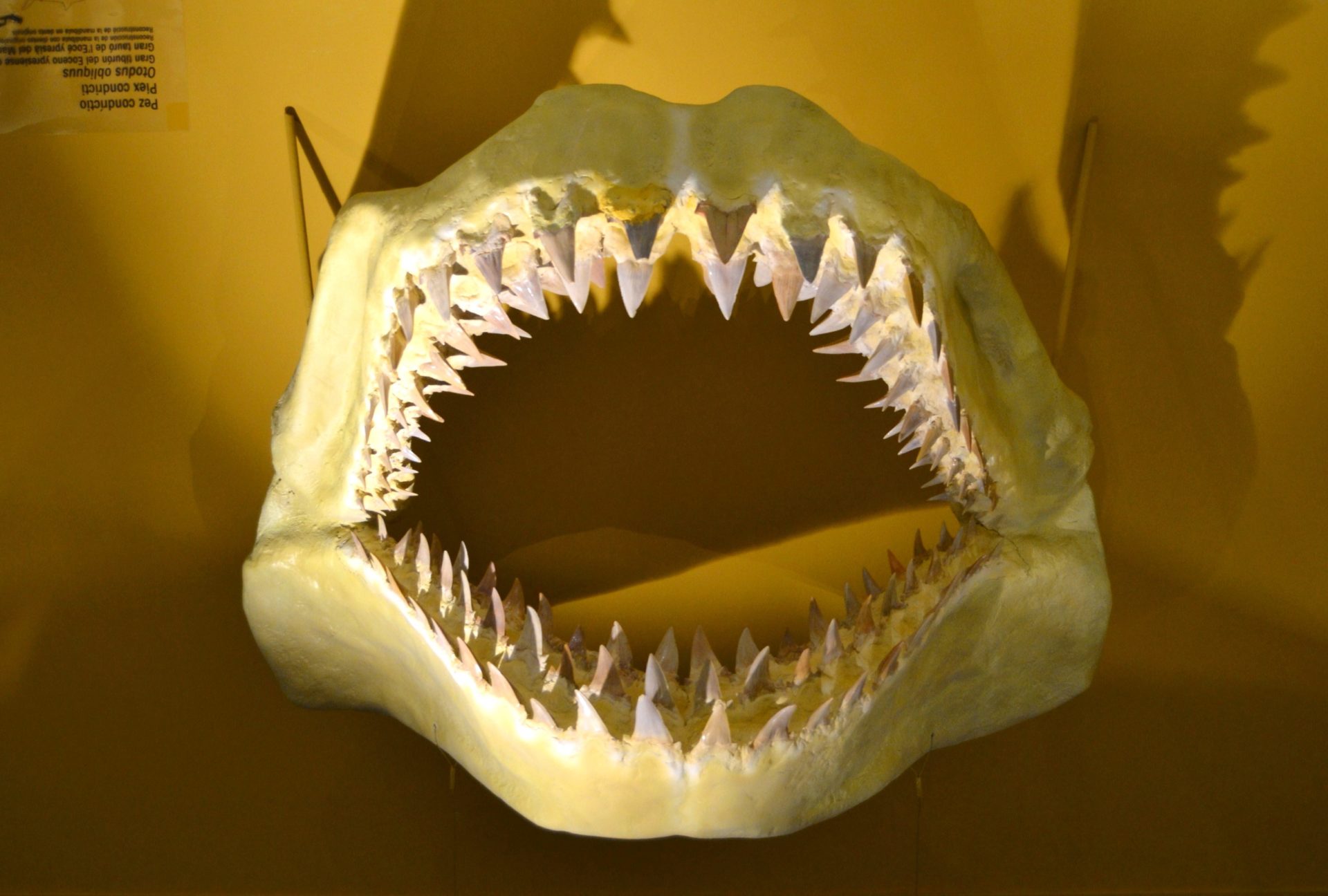
Note: If you think the above-image is inverted it is. That’s because the museum actually has the jaws mounted upside down! (I confirmed this by showing it to my peers, shown properly for accuracy)
Although Megalodon gets most of the press in books and film, I felt Otodus was impressive enough to deserve at least a “bit” part (pun intended) in one of my novels. This excerpt from my last novel, Kronos Rising: Kraken (volume 2), features Captain Natalya Dragunova, one of my protagonists, attempting to escape Cretaceous-era Diablo caldera with a badly wounded crewmember. The subsequent attack on their min-sub by a modern-day Otodus is my attempt at breathing life into this extinct killer. I hope you enjoy it.
“Hey, Bender, don’t you fucking die on me,” Natalya said, tapping him gently on the cheek.
He opened his eyes and stared at her. “Die my dear? Why, that’s the last thing I’ll do!”
When she stared uncomprehendingly at him, he said, “Supposedly, those were Groucho Marx’s last words. Get it, ‘the last thing I’ll do?’”
“Ah, I get eet,” she said, forcing a grin.
“I, um, I want you to promise me something, captain.”
“Da, what ees eet?”“If I don’t make it, please don’t let me come back as one of those things.”
Her expression turned morose and her gaze shifted to the scale-coated forearm, still laying on the deck beside them. “I don’t theenk it works like that.”
Bender nodded.
Out of nowhere, a high-pitched warning claxon drew Natalya’s attention back to the helm. Now what? Her lips curled back from her teeth as she saw the red lights flashing on their main sonar screen. She knew right away what it was. They had a proximity alert; something was coming for them.
Something big.
She was almost to the helm when there was a thunderous impact. The Remora tilted hard to port, like it had been struck by a giant fist, and a collision alarm began to sound.
“Computer, I have the conn!” Natalya shouted, strapping herself into the pilot’s chair and seizing the steering yoke. She checked her instruments and saw their reactive armor had gone off, reducing the force of the blow they’d received. “Assume copilot’s position and utilize auditory responses.”
“Working,” the system’s synthetic voice replied.
“Damage report!”
“There is no significant damage to the vessel at this time.”
Good. With one eye on the blip that now moved rapidly away from them, Natalya torqued the Remora hard to starboard, matching its speed and plotting an intercept course. “Computer, identify attacker.”
“Working. Attacker is a large biologic, size estimate nine meters. Mass est–”
“Fuck the mass!” Natalya snapped. She could see a shadowy form, just beyond visual range. “What ees eet?”
“Biologic’s designate is an elasmobranch. A shark.”
She breathed through her teeth as she brought their HYDRA cannons back online, the system’s virtual crosshairs appearing on the bow window. “Computer, what kind of shark?”
“Working. No exact match. Based on fossil record, the closest possible match is Otodus obliquus, an extinct species of lamniform shark from the–”
“Computer, enough,” Natalya said. “Track incoming biologic and transfer all unnecessary power to maneuvering thrusters.”
“Thrusters are now at maximum power.”
With her timber wolf’s eyes narrowed, Natalya accelerated to a crisp forty knots and aimed directly for the fast-moving shadow. Given their limited armament, she was relieved their attacker wasn’t an adult Kronosaurus imperator. But that didn’t make the situation any less perilous. Any shark that could survive alongside the deadliest predators on the planet had to be formidable.
She spotted it finally, fifty yards ahead and cruising around them in a wide arc. Its eight-foot caudal fin was whipping back and forth to increase thrust, and its wedge-shaped fins were extended for maximum maneuverability.
It was a big bastard, all right, Natalya thought, just like the computer said. It reminded her of a Shortfin Mako, albeit an eight-ton one. It had the same dark-bluish color above, with white below, but its now-burned snout was blunter, and the four-inch teeth that lined its yard-wide jaws had triple tips, like a drawerful of steak knives, robbed from Hell’s kitchen.
The Otodus, sensing that its prey had somehow survived its ambush, appeared confused. It accelerated and started moving in a descending spiral, trying to get underneath the mini-sub, to target its underbelly.
Natalya was no fool and cut it off. She could see its softball-sized black eye, staring back at her as she closed in. “That’s right, mudak. I’m planning to keel you, just like you’re planning to keel us.”
At around twenty-five knots, the shark reached its maximum speed. Natalya was befuddled. How its kind had managed to survive for countless millennia around bigger, faster marine reptiles was beyond her. She scoffed. It was irrelevant. She couldn’t chance the thing coming after them again; they needed to get home.
She went into a steep dive, outpacing the now-confused shark, until she had the big Gatling cannons’ sonar-based targeting system locked onto its gills. (to be continued)
©2017 Max Hawthorne, all rights reserved.
Special thanks to UK paleontologist Paul DeLasalle and Seth Sorensen from Fossil Shack (www.fossilshack.com) for their kind assistance.
Max Hawthorne
#princeofpaleofiction
#JawsMeetsJurassicPark
